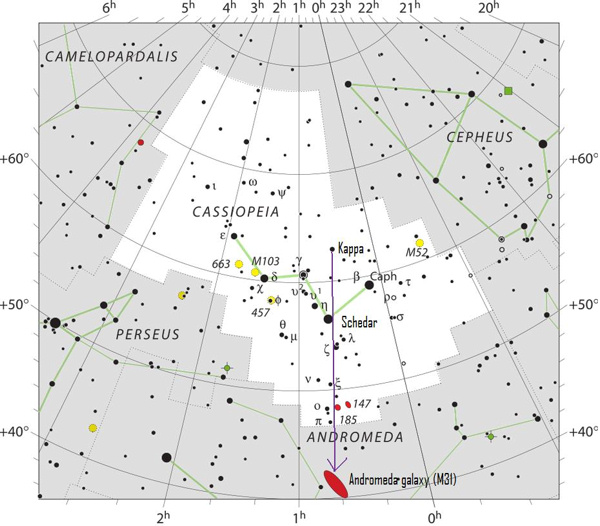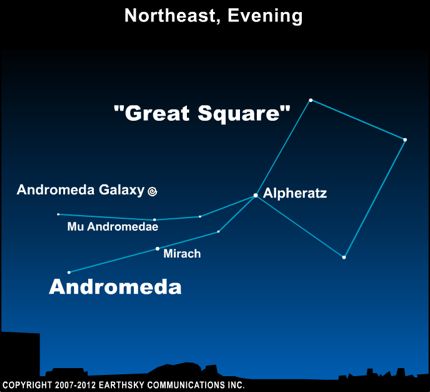
Tonight, since the moon is waning and gone from the sky in early evening, find the Andromeda galaxy, the great spiral galaxy next door to our Milky Way. It’s the most distant thing you can see with your eye alone. It’s best seen in the evening at this time of year, assuming you’re in the Northern Hemisphere. Most people find the galaxy by star-hopping from the constellation Cassiopeia, which is a very noticeable M- or W-shaped pattern on the sky’s dome. I learned to find the Andromeda galaxy by star-hopping from the Great Square of Pegasus, to the two graceful streams of stars making up the constellation Andromeda.
Look at the chart at the top of this post. It shows both constellations – Cassiopeia and Andromeda – so you can see the galaxy’s location with respect to both. Notice the star Schedar in Cassiopeia. It’s the constellation’s brightest star, and it points to the galaxy.

Draw an imaginary line from the star Kappa Cassiopeiae (abbreviated Kappa) through the star Schedar, then go about 3 times the Kappa-Schedar distance to locate the Andromeda galaxy (Messier 31). For another view, click here .
Now let’s take a closer look at the other way to find this galaxy:

Use the Great Square of Pegasus to find the Andromeda galaxy. Here’s how to do it.
The large square pattern above is the Great Square in the constellation Pegasus. The constellation Andromeda can be seen as two streams of stars extending from one side of the Square, beginning at the star Alpheratz.
Notice Mirach, then Mu Andromedae. An imaginary line drawn through these two stars points to the Andromeda galaxy.
Just be aware – bright moonlight or city lights can overwhelm the faint glow of this object. The single most important thing you need to see the galaxy is a very dark sky.
What does the galaxy look like to the eye? Assuming you have a dark sky, it appears as a large fuzzy patch – bigger than a full moon in the sky – but vastly fainter and more subtle.

View larger. | The Andromeda galaxy (upper right of photo) as seen by EarthSky Facebook friend Ted Van at a Montana campsite in mid-August. Thank you, Ted!
For binocular astronomers: Binoculars, as always, enhance the view. Binoculars are an excellent choice for beginners to observe the Andromeda galaxy, because they are so easy to point. As you stand beneath a dark sky, locate the galaxy with your eye first, then slowly bring the binoculars up to your eyes so that the galaxy comes into binocular view. If that doesn’t work for you, try sweeping the area with your binoculars. Go slowly, and be sure your eyes are dark-adapted. The galaxy will appear as a fuzzy patch to the eye. It’ll appear brighter in binoculars. Can you see that its central region is more concentrated?
With the eye, or with binoculars, or even with a backyard telescope, the Andromeda galaxy won’t look like the image below. But it will be beautiful. It’ll take your breath away.

Image of the Andromeda galaxy captured by NASA's Wide-field Infrared Survey Explorer. Image via NASA/JPL-Caltech/UCLA
One of you wrote:
I’ve heard that the Andromeda galaxy will someday collide with our galaxy! Is that still a definite possibility?
Definite possibility describes much of what we know – or think we know – about the universe. As for the Andromeda galaxy and its future collision with our Milky Way: the first attempt to measure the radial velocity of this galaxy (its motion forward or back, along our line of sight) was made in 1912. After that, astronomers believed for some decades that the galaxy was approaching at nearly 200 miles per second (300 km/s), but later astronomers disagreed.
Then in May 2012, NASA astronomers announced they can now predict the time of this collision of titan galaxies with certainty. Remember, though, that the Andromeda Galaxy is 2.2 million light-years away, with a single light-year being almost 10 trillion kilometers (6 trillion miles). So although it does appear that this galaxy is approaching our Milky Way galaxy … it’s nothing to lose sleep over. When will they collide? According to NASA astronomers in 2012, it’ll be four billion years from now.
Read more: Will the Milky Way and Andromeda galaxies collide someday?
Plus when galaxies collide, they don’t exactly destroy each other. Because there’s so much more space than stars in our universe, colliding galaxies pass through each other, like ghosts.
But colliding galaxies do interact. Check out this cool video: Night sky as Milky Way and Andromeda galaxies merge.
Bottom line: The Andromeda galaxy, aka M31, will be visible on dark, moonless evenings from now until the beginning of spring. This post tells you how to use the constellations Cassiopeia and Pegasus to find it. Be sure you’re looking on a moonless night, far from city lights. This galaxy is approaching our Milky Way galaxy, across the vastness of space. Astronomers say that – four billion years from now – our two galaxies will collide.
Donate: Your support means the world to us
from EarthSky https://ift.tt/2CIsqcS

Tonight, since the moon is waning and gone from the sky in early evening, find the Andromeda galaxy, the great spiral galaxy next door to our Milky Way. It’s the most distant thing you can see with your eye alone. It’s best seen in the evening at this time of year, assuming you’re in the Northern Hemisphere. Most people find the galaxy by star-hopping from the constellation Cassiopeia, which is a very noticeable M- or W-shaped pattern on the sky’s dome. I learned to find the Andromeda galaxy by star-hopping from the Great Square of Pegasus, to the two graceful streams of stars making up the constellation Andromeda.
Look at the chart at the top of this post. It shows both constellations – Cassiopeia and Andromeda – so you can see the galaxy’s location with respect to both. Notice the star Schedar in Cassiopeia. It’s the constellation’s brightest star, and it points to the galaxy.

Draw an imaginary line from the star Kappa Cassiopeiae (abbreviated Kappa) through the star Schedar, then go about 3 times the Kappa-Schedar distance to locate the Andromeda galaxy (Messier 31). For another view, click here .
Now let’s take a closer look at the other way to find this galaxy:

Use the Great Square of Pegasus to find the Andromeda galaxy. Here’s how to do it.
The large square pattern above is the Great Square in the constellation Pegasus. The constellation Andromeda can be seen as two streams of stars extending from one side of the Square, beginning at the star Alpheratz.
Notice Mirach, then Mu Andromedae. An imaginary line drawn through these two stars points to the Andromeda galaxy.
Just be aware – bright moonlight or city lights can overwhelm the faint glow of this object. The single most important thing you need to see the galaxy is a very dark sky.
What does the galaxy look like to the eye? Assuming you have a dark sky, it appears as a large fuzzy patch – bigger than a full moon in the sky – but vastly fainter and more subtle.

View larger. | The Andromeda galaxy (upper right of photo) as seen by EarthSky Facebook friend Ted Van at a Montana campsite in mid-August. Thank you, Ted!
For binocular astronomers: Binoculars, as always, enhance the view. Binoculars are an excellent choice for beginners to observe the Andromeda galaxy, because they are so easy to point. As you stand beneath a dark sky, locate the galaxy with your eye first, then slowly bring the binoculars up to your eyes so that the galaxy comes into binocular view. If that doesn’t work for you, try sweeping the area with your binoculars. Go slowly, and be sure your eyes are dark-adapted. The galaxy will appear as a fuzzy patch to the eye. It’ll appear brighter in binoculars. Can you see that its central region is more concentrated?
With the eye, or with binoculars, or even with a backyard telescope, the Andromeda galaxy won’t look like the image below. But it will be beautiful. It’ll take your breath away.

Image of the Andromeda galaxy captured by NASA's Wide-field Infrared Survey Explorer. Image via NASA/JPL-Caltech/UCLA
One of you wrote:
I’ve heard that the Andromeda galaxy will someday collide with our galaxy! Is that still a definite possibility?
Definite possibility describes much of what we know – or think we know – about the universe. As for the Andromeda galaxy and its future collision with our Milky Way: the first attempt to measure the radial velocity of this galaxy (its motion forward or back, along our line of sight) was made in 1912. After that, astronomers believed for some decades that the galaxy was approaching at nearly 200 miles per second (300 km/s), but later astronomers disagreed.
Then in May 2012, NASA astronomers announced they can now predict the time of this collision of titan galaxies with certainty. Remember, though, that the Andromeda Galaxy is 2.2 million light-years away, with a single light-year being almost 10 trillion kilometers (6 trillion miles). So although it does appear that this galaxy is approaching our Milky Way galaxy … it’s nothing to lose sleep over. When will they collide? According to NASA astronomers in 2012, it’ll be four billion years from now.
Read more: Will the Milky Way and Andromeda galaxies collide someday?
Plus when galaxies collide, they don’t exactly destroy each other. Because there’s so much more space than stars in our universe, colliding galaxies pass through each other, like ghosts.
But colliding galaxies do interact. Check out this cool video: Night sky as Milky Way and Andromeda galaxies merge.
Bottom line: The Andromeda galaxy, aka M31, will be visible on dark, moonless evenings from now until the beginning of spring. This post tells you how to use the constellations Cassiopeia and Pegasus to find it. Be sure you’re looking on a moonless night, far from city lights. This galaxy is approaching our Milky Way galaxy, across the vastness of space. Astronomers say that – four billion years from now – our two galaxies will collide.
Donate: Your support means the world to us
from EarthSky https://ift.tt/2CIsqcS

Aucun commentaire:
Enregistrer un commentaire